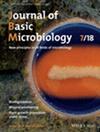Unveiling the Efficient Sodium Dodecyl Sulfate Degradation Potential of Pseudomonas nitritireducens Using Central Composite Design
Abstract
Sodium dodecyl sulfate, an anionic detergent, has extensive usage in several pharmaceuticals and household products. SDS contaminates the environment due to failure of conventional treatment methods to remove it completely from wastewater. Due to the eco-toxicity and health hazards of SDS, there is need of new and efficient methods of SDS removal. The present study is the first description on highly efficient SDS biodegradation and chemotaxis by Pseudomonas nitritireducens isolated from river sediments. SDS degradation kinetics using 50−1000 mg/L SDS concentration showed the highest degradation rate of 30.88 mg/L/h at 600 mg/L. The central composite design-face centered was used for optimization of SDS degradation resulting in 1.25-fold increase in degradation. 99.6% ± 0.018% SDS was degraded within 8 h of incubation in M9 minimal medium containing 200 mg/L SDS as the sole carbon source. The time of degradation reduced to 6 h when inoculum was induced for SDS degradation. To the best of our knowledge, the present study is the first description on SDS chemotaxis of P. nitritireducens showing the lowest period for degradation of environmentally relevant SDS concentration. Furthermore, the article provides the earliest report on use of response surface methodology for optimization of SDS degradation. The reported bacterium may provide competent alternative for SDS removal in wastewater treatment as well as new insights of SDS metabolism in bacteria on further exploration.


 求助内容:
求助内容: 应助结果提醒方式:
应助结果提醒方式:


